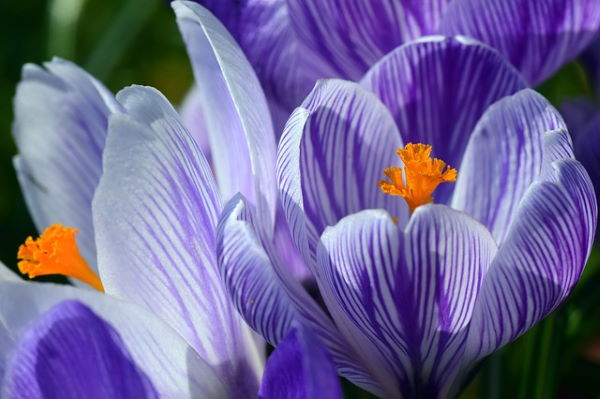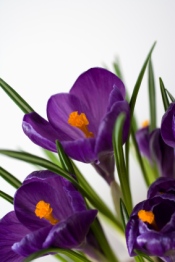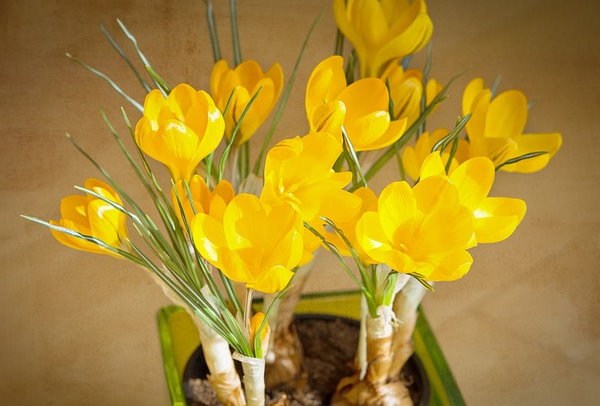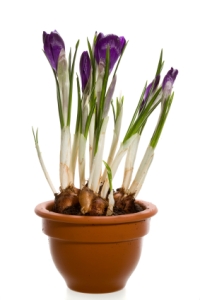Growing Crocus Bulb Indoors
Botanical Name: Crocus bulb hybrids
Crocus flowers are among the first to herald spring, sometimes popping their bright blooms through the snow. Fortunately, we don't have to wait till spring to enjoy these glorious flowers. Growing crocus indoors is easy to do by forcing them into bloom mid-winter. Start the process in fall -- October is an ideal time.
A crocus bulb is actually a corm. Corms produce beautiful cup-shaped blooms in purple, lavender, white or yellow -- plain or striped -- each with a bright orange stigma. All have slender, upright leaves that are green and white striped.
 Crocus 'Pickwick' has long been a popular variety. It's easy to see why. Photo: Ulrike Leone
Crocus 'Pickwick' has long been a popular variety. It's easy to see why. Photo: Ulrike LeoneBuying Crocus Bulbs

Choose good-sized corms that are firm -- not soft or mushy. Don't buy any that are sprouting. After waiting for months for these beauties to bloom, you don't want to be disappointed.
You'll find top-quality crocus corms at online nurseries in fall. Many varieties are available to choose from. Dutch crocus bulb hybrids are favored for their large blooms. Among the best for growing indoors... 'Pickwick' has silvery lavender petals with dark purple stripes... 'Remembrance' giant blooms are shiny, deep purple... and 'Flower Record' giant crocus is available in several colors.
Because each variety tends to bloom at a different time, it's best not to mix them. You'll enjoy a mass of beautiful blooms by planting one crocus bulb variety per pot.
How to Force Crocus Bulbs - Step by Step
Crocuses need a cold treatment for 12 weeks to bloom. If you bought pre-chilled corms, you can skip this step.
- Choose a shallow pot (at least 3 in/7 cm deep) with drainage holes in the bottom. Fill the pot loosely with potting mix. Set several corms side by side -- close but not touching -- pointed end up. Set corms so that their tips are even with pot rim. Do not press the corms into the mix. It should be loose so the roots can grow through it easily. Cover with additional potting mix until just barely covered.
- Water thoroughly and discard drainage.
- Move pot to a dark, cool, but not freezing, (40°F/4°C) location such as a basement, unheated garage or refrigerator. Avoid storing corms near ripening fruit or vegetables which give off ethylene gas which can damage the corms. Keep them in cold storage for about 12 weeks. Keep the medium barely moist.
- When shoots reach about 2 in (5 cm) tall, bring the pot out of cold storage and place it in a slightly warmer (50°F/10°C) location with low light intensity. Over the next few days, gradually move it toward a sunny window. Turn the pot every day for even growth. When in full bloom, keep crocuses in a bright location out of direct sun to prolong the bloom.
 Imagine bright yellow crocus flowers blooming in a sunny window mid-winter.
Imagine bright yellow crocus flowers blooming in a sunny window mid-winter.Crocus Care Tips

Origin: Hybrids with corms originating from Europe, North Africa and Asia
Height: Up to 8 in (20 cm)
Light: Keep in a dark location during cold treatment. Cover pot with a box, pot or black garbage bag if necessary. After shoots appear, move to bright light with some direct sun as directed above.
Water: Water sparingly until growth appears, then water enough to keep soil evenly moist. Flowering plants are thirsty, so check them often.
Humidity: Average room (around 40% relative humidity).
Temperature: Cool to average (40-60°F/6-16°C). Make your flowers last longer by keeping the plant in a slightly cooler location. Blooms will last for weeks if kept at a maximum of 60°F/16°C.
Soil: Any good-quality potting mix.
Fertilizer: Feed monthly with a balanced liquid fertilizer diluted by half from planting until start of blooming. Do not fertilize while plants are in bloom.
Propagation: Corms will not bloom a second time indoors. They do produce offsets, but they take a few years to mature. If you want to keep them, allow the foliage to die back naturally, then store them in a cool, dry place. Plant the corms in your flower garden in the fall and let Mother Nature take care of them. They'll bloom when they're ready.


